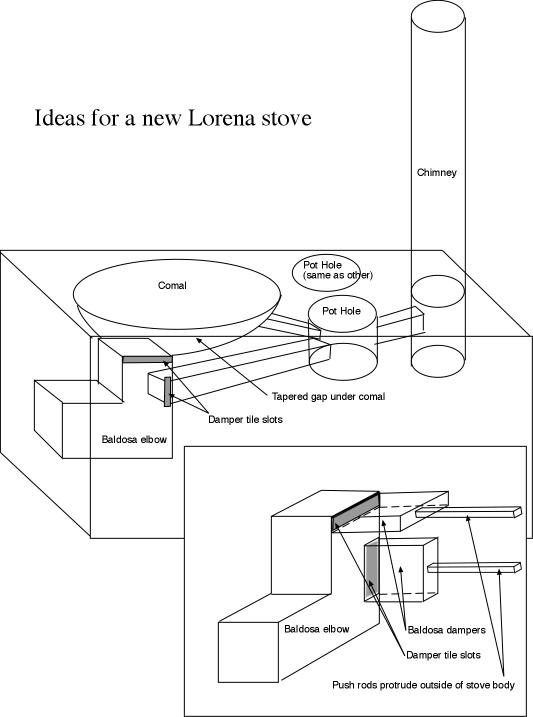
Dean Still and Jeremy Foster, ETHOS March 2003
Jeremy Foster is working on a new Lorena type stove in Mexico. Here are a few details:
Jeremy Foster:
I am located in and around Lake Patzcuaro, about a 4 hr. drive west of Mexico City. The closest airport, 1 hr. away, is Morelia, which has many flights from Mexico City. However, coming from the western US it is better and cheaper to fly to Guadalajara, 3 1/2 hr. drive in the other direction.
Total population in the region is some 600,000 of which about a quarter are pure Tarascan. The main features of the most popular Lorena model are: A 50 cm. dia. clay comal in front over a single firebox. Two smaller holes (18-25 cm.) are side by side behind, with separate tunnels leading from the comal hornilla. These holes are sized to a particular family's need and due to shape of ollas are sunk in no more than 5 cm. below the surface. All ollas and cazuelas are ceramic and round-bottomed. Clay comals are used pretty exclusively. Metal comals have been very unpopular.
I had thought at first I would build a plancha stove with cutouts for comal, etc. On reflection, it seems to me it might be better to modify one of these Lorena stoves using rocket stove principles in order to more directly compare the two. I have been experimenting with the local baldosas which appear very suitable. The most useful size is 30cm. which actually
measures a little under 11" square X 1 1/8". I have gotten an elbow as hot as I could then doused it with cold water with no ill effect. The drawback is that the interior size is only 4" square. They also make one measuring 14"square. By also using this one to make a 7" wide back, I have made one with interior size 4 3/4" X 4 3/4" which seems about right but involves a lot of cutting and wastage.
Am amazed and grateful for all the great advice pouring in. Certainly a lot to think about.
The baldosa cutting sequence is just great and my hacksaw just can't through a 14" baldosa anyway, although I wonder if a 14" chimney with 6" square opening might not be good power for a nixtamal stove.
Thanks, Dean, for help with modified Lorena. The ceramic comal stays in place, sealed around edges, never removed. I don't have answer yet as to heat that rear ollas receive with Lorena. Note that they are side by side with separate channels leading to each from the edge of the comal. Therefore each receives the same amount of heat, which I suspect, is often
not enough. A couple of the stove models built here have a second firebox on the side under one of the olla holes, although I would like to avoid doing this. Hope to build a prototype in the next few days. Will keep you posted.
By the way, the ladies in my household inform me that the problem with metal comals burning the tortillas is due to the thinness of the steel. The problem is solved with a thicker
section.
Dean Still
 |
OK, so the big comal stays in place. I have trouble believing that after passing over the very large surface area of the big comal that, even in a
insulated Rocket stove, there would be enough heat left to boil a bean pot. In my experiments with multiple pot stoves I ended up with a very low powered second burners in situations like this.So, if it becomes necessary, Jeremy, I would experiment along the lines of the drawing I am sending attached. Dampers made from baldosa shut off the
heat from the comal. The dampers slide in horizontally or vertically. I would make the damper very long so it does not want to fall into the elbow AND I would put it in a concrete trough in which it slides.
The comal might be placed off center on top of the elbow so that heat drawn by the draft evens out temperatures across the surface. If the comal is
centered I'm afraid that 1/2 the comal will be cold because the suction only pulls heat in one direction. Quien sabe, if this is so.
I would probably spend 2-4 weeks full time making models to solve a few of the situations in this stove. BEST OF LUCK, AMIGO MIO!!!
The drawing is not accurate, only shows ideas. The cross sectional area should be constant in the tunnels, etc.
My charcoal/clay lightweight stucco is dry and tomorrow I'll try it but I have no idea whether it will work. It's just that with all the baldosa
backed up by insulation in this stove you will be getting very heavy no matter what you do. Using insulative boards would make a much faster
reacting stove. So I will continue experimenting. If Damon or Ken happen to come by, please ask them to whip you up a few square yards of perlite/clay
or sawdust/clay material!
Aprovecho Research Center
www.efn.org/~apro